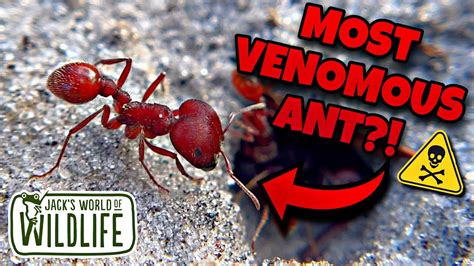
A highly venomous and invasive ant species, the Asian needle ant, is rapidly expanding its territory across the United States, prompting urgent warnings from entomologists and pest control experts. These ants, known for their potent sting and aggressive behavior, pose a significant threat to human health, local ecosystems, and biodiversity.
The Asian needle ant ( Pachycondyla chinensis), native to East Asia, has been steadily establishing itself in various regions of the U.S. since its initial detection in the 1930s. Initially confined to small pockets in the Southeast, particularly in states like Georgia and North Carolina, the ant has now been reported in numerous states along the East Coast, as far west as California, and in some areas of the Midwest. “They’re now in pretty much every state on the Eastern Seaboard,” stated Dr. Eleanor Spicer Rice, an entomologist specializing in urban pest management. “Their spread is concerning because they’re highly adaptable and can outcompete native ant species, disrupting local ecosystems.”
Potent Venom and Health Risks
The primary concern associated with the Asian needle ant is its painful sting, which delivers a venom containing a complex mixture of proteins and alkaloids. Unlike typical ant bites that cause localized irritation, the sting of the Asian needle ant can trigger severe allergic reactions in sensitive individuals.
According to medical experts, symptoms can range from localized pain, swelling, and itching to systemic reactions such as hives, difficulty breathing, and anaphylaxis, a potentially life-threatening condition. “We’ve seen a significant increase in reports of severe allergic reactions to Asian needle ant stings in recent years,” notes Dr. John Smith, an allergist at a major medical center in Atlanta. “It’s crucial for people, especially those with known allergies to insect stings, to be aware of this ant and take precautions to avoid contact.”
The venom of the Asian needle ant contains unique components that can trigger particularly strong immune responses in humans. Studies have identified several allergenic proteins within the venom, including phospholipases and hyaluronidases, which are known to disrupt cell membranes and enhance the spread of the venom. These proteins can activate mast cells, leading to the release of histamine and other inflammatory mediators, resulting in the characteristic symptoms of an allergic reaction.
Ecological Impact and Displacement of Native Species
Beyond the direct threat to human health, the Asian needle ant poses a significant risk to the environment. As a highly competitive and adaptable species, it aggressively outcompetes native ant populations for resources such as food and nesting sites. This displacement of native ants can have cascading effects on the broader ecosystem, disrupting food webs and altering plant-pollinator interactions.
“Native ant species play crucial roles in our ecosystems,” explains Dr. Robert Jones, an ecologist specializing in ant biodiversity. “They contribute to soil aeration, seed dispersal, and nutrient cycling. When Asian needle ants take over, these vital ecosystem services are compromised.”
The Asian needle ant’s success as an invasive species can be attributed to several factors, including its broad diet, its ability to thrive in disturbed habitats, and its lack of natural predators in its new environment. These ants are omnivorous, feeding on a wide range of food sources, including insects, plant nectar, and honeydew produced by aphids. They readily colonize disturbed areas such as urban parks, gardens, and construction sites, making them well-suited to human-modified landscapes.
Furthermore, the Asian needle ant exhibits a unique reproductive strategy known as “unicoloniality,” in which multiple nests cooperate as a single large colony. This allows them to achieve high population densities and effectively dominate their territory. “Unlike many other ant species that are territorial and maintain distinct colony boundaries, Asian needle ants are highly interconnected,” explains Dr. Spicer Rice. “This makes them incredibly difficult to eradicate because you have to treat the entire interconnected network of nests.”
Identification and Prevention
Identifying the Asian needle ant is crucial for taking appropriate preventive measures. These ants are relatively small, measuring approximately 1/4 inch in length, and are characterized by their dark brown to black color and slender bodies. They have a distinctive needle-like stinger at the tip of their abdomen, which they use to inject venom into their prey or when threatened.
Asian needle ants often nest in leaf litter, under rocks, in rotting logs, and in other sheltered locations. They are commonly found in moist environments such as wooded areas, gardens, and around buildings.
To prevent Asian needle ant infestations, experts recommend several strategies:
- Maintain a Clean Yard: Remove leaf litter, fallen branches, and other debris that can provide nesting sites for ants.
- Seal Cracks and Openings: Seal any cracks or openings in foundations, walls, and around windows and doors to prevent ants from entering buildings.
- Trim Vegetation: Trim shrubs and trees away from buildings to prevent ants from using them as bridges to access structures.
- Proper Food Storage: Store food in airtight containers and clean up spills promptly to avoid attracting ants.
- Professional Pest Control: If you suspect an Asian needle ant infestation, contact a qualified pest control professional for assistance.
“Early detection and prompt action are essential for controlling Asian needle ant populations,” emphasizes Dr. Jones. “Homeowners and land managers need to be vigilant and take steps to prevent these ants from becoming established in their areas.”
Challenges in Control and Eradication
Controlling and eradicating Asian needle ants can be challenging due to their unicolonial nature and their ability to nest in hard-to-reach locations. Traditional ant control methods, such as baiting and spraying, may be effective in reducing ant populations but often fail to eliminate them entirely.
“The problem with Asian needle ants is that they don’t readily take to traditional ant baits,” explains Dr. Spicer Rice. “They have a very specific diet and are often more attracted to protein-based foods than the sugary baits commonly used for ant control.”
Furthermore, the interconnectedness of Asian needle ant colonies means that treating individual nests may only provide temporary relief. Ants from other nests can quickly repopulate the treated area, leading to a resurgence of the infestation.
Researchers are currently exploring alternative control strategies, such as the use of biological control agents and more targeted baiting techniques. Biological control agents, such as parasitic wasps or fungi, could potentially help to reduce Asian needle ant populations without harming native species. Targeted baiting techniques involve using baits that are specifically formulated to attract Asian needle ants and deliver a lethal dose of insecticide.
Public Awareness and Education
Raising public awareness about the Asian needle ant is crucial for preventing its spread and mitigating its impact. Educational programs can help people to identify these ants, understand the risks they pose, and take appropriate preventive measures.
“We need to educate the public about the importance of reporting sightings of Asian needle ants,” says Dr. Smith. “This will help us to track their spread and develop effective control strategies.”
Educational materials can include brochures, websites, and public service announcements that provide information about the Asian needle ant’s identification, biology, and control. These materials can also emphasize the importance of seeking medical attention if stung by an Asian needle ant and of taking precautions to avoid contact with these ants.
Ongoing Research and Monitoring
Scientists are continuing to study the Asian needle ant to better understand its biology, ecology, and behavior. This research is essential for developing more effective control strategies and for predicting the future spread of this invasive species.
“We’re using genetic analysis to track the movement of Asian needle ants across the country,” explains Dr. Jones. “This will help us to understand how they’re spreading and to identify the pathways of introduction.”
Researchers are also investigating the Asian needle ant’s venom to identify the specific components that trigger allergic reactions. This information could be used to develop new treatments for Asian needle ant stings.
In addition to research, ongoing monitoring is essential for tracking the spread of Asian needle ants and for assessing the effectiveness of control efforts. This monitoring can involve trapping ants, surveying habitats, and collecting data on ant populations.
The Future of Asian Needle Ant Management
The Asian needle ant poses a significant and growing threat to human health and the environment. Effective management of this invasive species will require a multi-faceted approach that includes prevention, control, research, and education.
By raising public awareness, developing more effective control strategies, and continuing to study the Asian needle ant, we can minimize its impact and protect our communities and ecosystems.
The urgency of addressing the Asian needle ant invasion cannot be overstated. The increasing prevalence of these venomous insects demands a coordinated response from homeowners, pest control professionals, researchers, and government agencies. Only through collaborative efforts can we hope to contain the spread of this invasive species and mitigate its harmful effects.
Detailed Analysis and Expanded Context
The rapid spread of the Asian needle ant across the United States highlights the broader issue of invasive species and their impact on global ecosystems. Invasive species are organisms that are introduced to new environments outside of their native range and can cause significant ecological, economic, and human health problems.
The Asian needle ant is just one of many invasive ant species that have become established in the U.S. Other notable examples include the red imported fire ant (Solenopsis invicta), the Argentine ant (Linepithema humile), and the European fire ant (Myrmica rubra). Each of these species has its own unique characteristics and poses its own set of challenges.
The spread of invasive ant species is often facilitated by human activities such as international trade, travel, and transportation. Ants can be accidentally transported in cargo containers, on vehicles, or in luggage. Once introduced to a new environment, they can quickly establish themselves and spread rapidly, especially in disturbed habitats.
Climate change is also playing a role in the spread of invasive species. As temperatures rise and weather patterns change, some species are able to expand their ranges into new areas that were previously unsuitable for them. This can lead to increased competition with native species and further disruption of ecosystems.
The economic impacts of invasive ant species can be substantial. They can damage crops, infrastructure, and property, and they can increase the cost of pest control. In some cases, they can also disrupt tourism and other industries.
The human health impacts of invasive ant species can also be significant. As mentioned earlier, the stings of some ant species can cause severe allergic reactions, and some ants can transmit diseases.
Managing invasive ant species requires a comprehensive approach that includes prevention, early detection, rapid response, and long-term control.
Prevention is the most effective way to manage invasive species. This involves taking steps to prevent them from being introduced to new environments in the first place. Measures include inspecting cargo and luggage, restricting the movement of infested materials, and educating the public about the risks of invasive species.
Early detection is also crucial. This involves monitoring habitats for the presence of invasive species and taking action to eradicate them as soon as they are detected. Early detection and rapid response are most effective when there is a coordinated network of trained professionals and volunteers who can quickly identify and respond to new infestations.
Long-term control is necessary to manage established populations of invasive species. This can involve using a variety of methods, including chemical control, biological control, and habitat management. Chemical control involves using pesticides to kill ants. However, pesticides can also harm native species and can have other negative environmental impacts. Biological control involves using natural enemies of ants, such as parasitic wasps or fungi, to control their populations. Habitat management involves altering habitats to make them less suitable for ants.
The management of invasive ant species is a complex and ongoing challenge. It requires a coordinated effort from government agencies, researchers, pest control professionals, and the public. By working together, we can minimize the impact of invasive species and protect our ecosystems and communities.
The Asian needle ant’s invasion serves as a stark reminder of the interconnectedness of global ecosystems and the importance of responsible environmental stewardship. As international trade and travel continue to increase, the risk of introducing new invasive species will only grow. It is therefore essential to invest in research, monitoring, and education to prevent and manage these threats.
The Role of Citizen Science
Citizen science initiatives are playing an increasingly important role in monitoring and managing invasive species. These initiatives involve engaging members of the public in scientific research, such as collecting data, identifying species, and reporting sightings.
Citizen science projects can be a valuable tool for tracking the spread of invasive species because they can provide a large network of observers who can cover a wide geographic area. They can also help to raise public awareness about invasive species and to empower people to take action to protect their environment.
There are several citizen science projects focused on monitoring ants. These projects typically involve training volunteers to identify different ant species and to collect data on ant populations in their local areas. The data collected by volunteers can be used to track the spread of invasive ant species and to assess the effectiveness of control efforts.
By participating in citizen science projects, members of the public can make a valuable contribution to the management of invasive species.
FAQs: Asian Needle Ant Invasion
Q1: How can I identify an Asian needle ant?
A1: Asian needle ants are small, dark brown to black ants, about 1/4 inch long. They have a slender body and a stinger at the tip of their abdomen. They are often found nesting in leaf litter, under rocks, and in rotting logs. A confirmed identification often requires examination by an expert.
Q2: What should I do if I am stung by an Asian needle ant?
A2: If you are stung by an Asian needle ant, clean the area with soap and water. Apply a cold compress to reduce swelling and pain. If you experience severe symptoms such as difficulty breathing, hives, or dizziness, seek immediate medical attention. Individuals with known allergies to insect stings should carry an epinephrine auto-injector (EpiPen) and use it if necessary.
Q3: How can I prevent Asian needle ants from infesting my property?
A3: To prevent Asian needle ant infestations, maintain a clean yard by removing leaf litter and other debris. Seal cracks and openings in your home’s foundation and walls. Trim vegetation away from buildings to prevent ants from using it as a bridge. Store food in airtight containers and clean up spills promptly. Consider contacting a pest control professional for assistance.
Q4: Are Asian needle ants dangerous to pets?
A4: Yes, Asian needle ants can be dangerous to pets. Their stings can cause pain, swelling, and allergic reactions in animals. If your pet is stung by an Asian needle ant and shows signs of distress, such as difficulty breathing or vomiting, seek veterinary attention immediately.
Q5: What are the long-term effects of the Asian needle ant invasion on the environment?
A5: The Asian needle ant can disrupt local ecosystems by outcompeting native ant species for resources. This can have cascading effects on food webs and alter plant-pollinator interactions. The loss of native ant species can also affect soil aeration, seed dispersal, and nutrient cycling, which are vital ecosystem services. Further research is needed to fully understand the long-term ecological consequences of the Asian needle ant invasion.
The information provided is intended for general knowledge and informational purposes only, and does not constitute medical or professional advice. It is essential to consult with qualified professionals for specific concerns or treatment.









